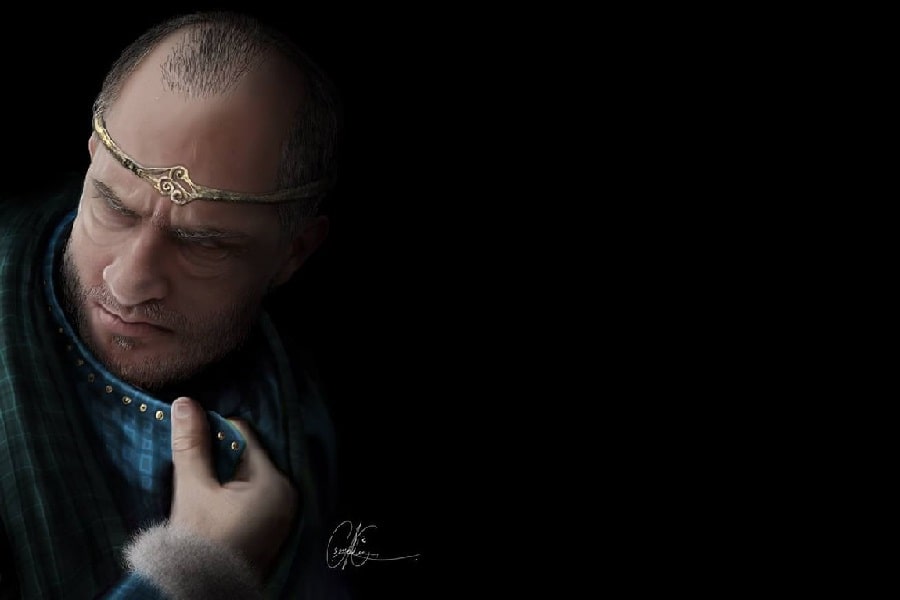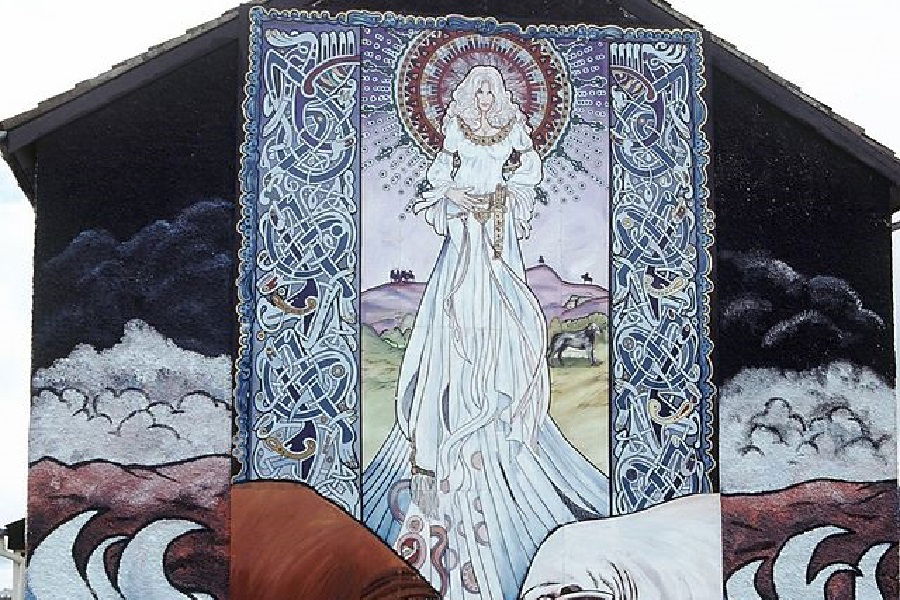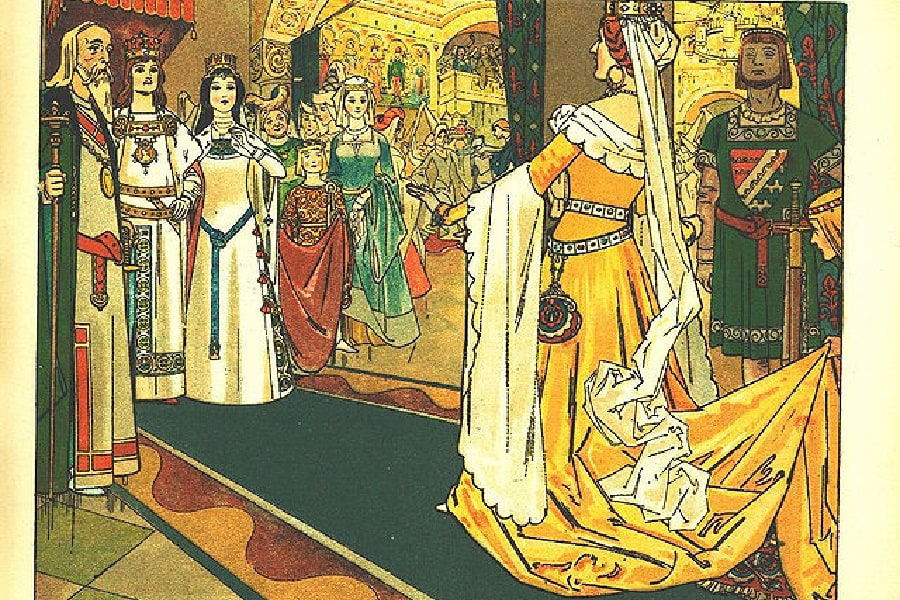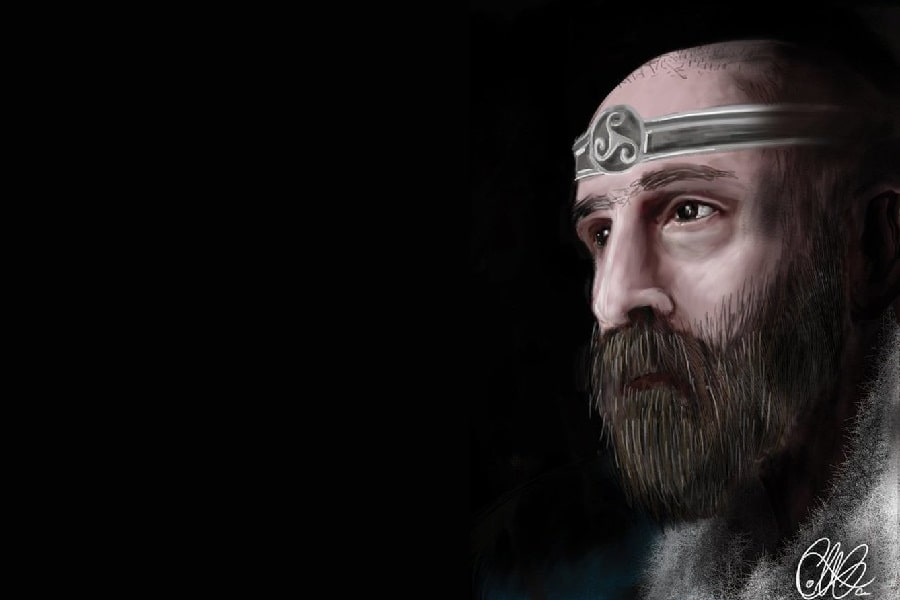Myths have, per definition, a certain level of fiction to them. Whether you think about Greek mythology, Chinese gods and mythology, or anything in between: they are never fully true. In fact, the characters in the stories often didn’t exist.
Celtic mythology is a bit different, and Medb, the queen of Connacht and the goddess of sovereignty, is a perfect example of that. We can say with a level of certainty that she has actually lived. So, who is Medb exactly, and why is she different from figures seen in other traditions?
Table of Contents
Celtic Mythology: What is It and Where is Medb?

It might be good to first determine what exactly Celtic mythology is, or rather what tradition Medb belonged to. See, the Celtic world was quite vast and covered space from western to central Europe. To add, it wasn’t at all unified in any sense of the word. From politics to culture, there were quite big differences to be seen.
Different Languages, Different Cycles
Because of this diversity, religion and related mythology were also quite different in any given place. There are descriptions of more than three hundred deities uncovered, which would go on to influence many deities of the Roman world. One of the most prominent examples of this is the Celtic goddess Epona.
The ‘official’ pantheon of Celtic gods and goddesses is, however, considered to be somewhat unified across the Celtic world. The roles of these gods and goddesses are, on the other hand, mostly different.
Celtic Language
These differences rely predominantly on the language in which they were formulated, being either in Goidelic languages (probably better known as ‘Gaelic’ languages) or Brythonic languages (Welsh, Cornish, and Breton).
The Goidelic languages gave birth to different ‘cycles’ in Irish Mythology, namely the Mythological Cycle, the Ulster Cycle, the Fenian Cycle, and the Cycle of Kings. The Brythonic languages gave birth to mythological traditions, like Welsh mythology, Cornish mythology, and Breton mythology.
Of Cycles and Traditions
The difference between the ‘cycles’ and the tradition is actually quite hard to pin down. Outside of the difference in languages, it seems to be that a cycle focuses on one house of a king and every story that applies to that family or house. A tradition on the other hand is wider and goes outside of just the king’s house and family.
To put it in Harry Potter terms: Griffyndor would be a cycle, while Gryffindor, Ravenclaw, Hufflepuff, and Slytherin together would be considered a tradition.
Where Does Medb Reside in Celtic Mythology?
But, we’re not talking about good old Harry. So, back to the topic of today, Medb. Her stories are formulated in the Goidelic language and all of her myths are part and parcel of the Ulster Cycle.
The Ulster Cycle is a body of medieval Irish legends and sagas of the Ulaid. This is basically a province of contemporary Northern Ireland, around the area of Belfast. The cycle focuses on the mythical Ulster king and his court at Emain Macha, which would rule over at least four counties: county Sligo, county Antrim, county Tyrone, and county Roscommon.
How Important Was Medb in the Ulster Cycle?
In the story, Medb is the one with whom the king has a conflict. So, she is not necessarily the most central character of the cycle, but without her presence, it probably couldn’t be considered an actual and distinct mythical cycle.
Hopefully, it is still somewhat understandable. Although Celtic mythology is vast and diverse, Medb basically plays an important role in one of the prominent storylines within Celtic mythology. Because of what she represents, she might exceed the importance that is normally given to your ‘average’ god.

Medb and Her Family
While often referred to as a goddess, Medb actually takes on the role of a queen within the Ulster cycle. Of course, this indicates that she comes from a royal family. That is indeed true, so how does that work?
King of Tara
At the most basic level, Medb is oftentimes considered to be one of the daughters of the king of Tara. This king is perceived to have ruled over the territory that fell under the ‘Hill of Tara’. The king, so the father of Medb, was called Eochu Feidlech.
It’s a position with a highly powerful status and is often perceived as the sacred kingship of Ireland. Around the ninth and tenth centuries BC, we can say for sure that it’s an actual position that was held by a human being. So not necessarily a figure that is generally considered a deity or god which has never set a foot on the earth.
Was Medb a Real Person?
While the story of Medb originates way earlier than the last documented kings of Tara we can trace back in the books, it is very plausible that she and her father were people that have actually lived on earth.
But, then again, the position of her father was also often referred to as the ‘High King’. Since the name ‘High King’ was already used at the time that Medb’s father should have been on the throne, it might be true that originally it was just someone high up in the sky. In that case, it can also be interpreted as a deity that would only later become a real person.
Both versions can be true. But, for the sake of the story, it’s nice to think that queen Medb and her family have actually lived the stories that you are about to read. Well, for the sake of the story that is. All the deaths involved might be a little less pleasant to be actually real.
Mom, Brothers, and Sisters of Medb
A royal family can’t just consist of a king and daughter, of course. The wife of the king was named Cloithfinn, just another unpronounceable name. Outside Medb, one other daughter is relevant in this story. But, in fact, Cloithfinn and her husband would have a total of six daughters and four sons. Including, of course, Medb.
Husbands and Sons of Medb
Medb herself had quite an eventful life. She has had multiple husbands with whom she had multiple children. Some of them tried to kill her, others tried to love her. We will get into the specifics later on, but for now, it suffices to say that she was first married to Conchobar mac Nessa, who was considered to be the king of Ulster. With him, she had a son by the name of Glaisne.
Her second husband would come and go in a flash, and she wouldn’t have any children with him. With her third husband, King Ailill mac Máta, Medb had seven children in total. All of them were, in fact, sons. Also, all of them were named Maine.
A lack of inspiration? Not really, because Medb actually has a good reason to name all her sons the same. For now, you have to do it with this limited information. Later on, we will discuss what the reason was.
To wrap up all the family affairs of Medb, her last child would become her only daughter. She was named Findabair, and she was often thought to be as cunning and beautiful as her mother was.

What Does the Name Medb Mean?
Literally translated, Medb would mean something like ‘strong’ or ‘intoxicated’. The two words are quite distinct, yet they describe the queen quite well.
The name Medb comes from the early modern Irish word Meadhbh. This would mean ‘she who intoxicates’. Quite impressive that a language allows that to be formulated in just one word with two vowels.
Maeve and Alcohol
Sometimes, she is also referred to as queen Maeve. This would basically be the corrupted version of Medb, which was the result of bad handwriting or writing the name in italics.
As also seen in other religions and myths, alcohol plays quite a big role for Medb. In her case, this was exactly because of the name Maeve.
How and why? Well, Maeve comes from the word mead; which is an alcoholic honey beverage. Alcohol, as many of you will know, is an intoxicating beverage, making the relation between queen Medb and alcohol logical.
The Different Roles of Medb
It is not for nothing that Medb literally translates to intoxicating and strong. The legend has it that she drove men wild at the mere sight of her. Wild with desire, that is since she was absolutely stunning and clothed herself beautifully. Even the birds would just fly to her arms and shoulders.
The ‘strong’ part also is legitimate, since she was able to run faster than any horse. Because of this, she is often referred to as a warrior queen.
Queen or Goddess?
The fact that many people call Medb a goddess is definitely legitimate for the simple fact that it is true. She is considered to be a priestess that represents sovereignty. But, she might not be a goddess in the way we would think about it.
In any way, her role as the goddess of sovereignty meant that she was able to bestow sovereignty to any king by wedding him and sleeping with him. In a sense, she is the goddess who presents the draught of sovereignty to one ruler and husband in the shadow of another.

What is Medb the Goddess Of?
So, that makes Medb the sovereign goddess. Some sources, too, claim her to be the goddess of territory. That’s because, at the end of the day, potential kings who wanted to rule Tara or Connacht had to sleep with her before they were in the position to rule. In theory, she, therefore, decided who was allowed to rule over a certain piece of territory.
Her functions as a goddess of territory and sovereignty are often symbolized by a woman offering a man a drink from a chalice. Following the name Maeve as explained earlier, this drink would more often than not be an alcoholic beverage.
In case you were wondering, Ireland ranks among the heaviest-drinking countries in the world. This, too, stressed the importance of the view of our discussed queen and goddess.
Medb’s Appearance
Medb is normally depicted with two animals by her side, namely a squirrel and a bird sitting on her shoulder. It resembles some goddesses of fertility in other religions, which is also affirmed by the fact that she is thoroughly connected to a sacred tree. The tree is called Bile Medb. However, her actual role as a goddess of fertility is never confirmed by scientists.
Normally, her depictions look you in your eyes with a seducing and playful smile. Beautiful as she was, she is also often seen in her own chariot. This relates to her role as the Irish warrior queen, riding with her men into battle.
Making Sense of Medb
Before we dive into the myths Medb was involved in, it is important to stress the importance of the powerful queen. Or rather, it is important to understand what Medb represented and why she was very different from any other mythological tradition.
The Devine Feminine
Queen Medb is a very difficult woman to grasp and pin down, not for the least because it was more so Medb’s lover that was the one that did the ruling. If Medb wanted someone to rule the territory of Tara, she could do so. But if not, she was the one that inhibited people from ruling it.
During her ‘reign’ over Ireland, the women are believed to maintain a status of freedom and equality which was not always seen in territories outside of Ireland. Our legendary queen can definitely be tough to interpret with the knowledge we have in our modern culture.
Equality Between Women and Men (?)
Indeed, she defies the thing that many movements are fighting for: equal rights and treatment of women. In the era of Medb, women could very well be regarded as more important than men. Although it is a hot topic in the 21st century, Medb seems to be the epitome of women’s rights.
That is not to say that she represents equality between the two sexes. It shows another interpretation of what relationships between men and women mean. These things are far from unilinear, although modern-day society likes to think they are not.
That is to say, every society and culture is different and we can’t expect everyone to hold the same values as we have. Perceptions like the one that Medb provides to us only help with imagining different ways our societies can, or should, be designed.
Myths of Medb: Her Many Husbands
The question still to be answered is how Medb was described in the stories of the Ulster cycle. Well, it’s a fine piece of Irish folklore and goes as followed.
First Husband
As indicated earlier, Medb was the daughter of the high king of Ireland. As so often in these royal houses, she was ordered to marry someone from another house. In the case of Medb, this would be Conchobar mac Nessa, who was the actual ruler of Ulster. With little to choose from, Medb married the king of Ulster and, therefore, could call herself queen Medb from now on.

They had a son by the name of Glaisne. But, these arranged marriages are really hit or miss. In the case of queen Medb and her first husband, it was a definite miss. Medb decided to leave the marriage and return to the house where she was born.
Now let’s take a look at Medb’s sister, Eithne. She had little hesitation to marry the man that was previously the husband of Medb. This didn’t make Medb very happy, so she decided to kill her.
Eithne was already pregnant when she was killed, nine months to be exact. In order to save the unborn child, doctors extracted the baby via a cesarean section. The little infant was called Furbaide.
Conchobar Raped Medb
Not long after, the father of queen Medb deposed the ruler of Connacht, after which Medb gladly took his place. Connacht is basically another province in Ireland.
The only thing was that Medb didn’t want more bloodshed. By claiming she wanted to be co-ruler together with the deposed ruler, she hoped to prevent any more battles.
As per usual, this meant marriage, with Medb seeing her second of many husbands. The young man, Tinni mac Conri, gladly accepted the offer. As per tradition, it was time for Medb to be inaugurated to the throne.
This was obviously big news, and her ex-husband Conchobar was aware of what was going on. He would come to the inauguration ceremony, but not with all the right intentions. In fact, Conchobar raped Medb as pure revenge for the death of Conchobar’s wife.
More Death, War, and New Criteria
Medb’s new husband planned to kill Conchobar in single combat. Unfortunately, Conchobar had different plans and easily overcame Tinni’s idea of single combat. Indeed, he slayed him without too much drama.
It was time for queen Medb to turn the wheel. After all, the marriage she had had thus far was not satisfying, if not depressing. She set forth three new criteria for all of her future husbands.
One, he has to be fearless. A warrior queen deserves a warrior king. Two, he had to be kind because, well, it’s nice to have someone who is kind. The last criterion was that he couldn’t have any jealousy towards her. After all, it should be understood that Medb was a woman with many lovers.
Finding the Perfect Husband for Queen Medb
Remember, Medb was still the queen of Connacht at this point. But, instead of being one of the co-rulers, she was just the only one that was in charge.
With her three criteria in mind, she started to search for a new man. Really, only a small group of men were fitting her demands. Eventually, she married Eochaid Dála. But, she didn’t really judge him well because he would break one of her criteria quite quickly. Indeed, he showed jealousy towards one of her lovers.
He actually wanted to fight one of them by the name of Ailill mac Máta. As you might remember, he would become one of Medb’s husbands too. Well, this is the point where it happened. Ailill would kill Eochaid and he would be transformed into a husband Ailill.
Together, they had seven sons. Still feeling a deep desire for revenge on Conchobar, they would all be named Maine. That’s because one prophecy foretold that someone with that exact name would eventually be the death of Conchobar.

Myths of Medb: The Cattle Raid of Cooley
Medb’s powers to intoxicate others with her charms sometimes got back to her. Or more so, she would intoxicate herself with greed. One of her bad habits was that she always wanted to be richer than her husband.
This showed when her husband acquired a valuable stud bull. Without much hesitation, she was dedicated to finding a similar stud bull with the same or higher value.
There was only one, however, by the name of Donn Cúailgne. The bull was located in Ulster, and the desire to own it was too big for queen Medb. She went there and offered to buy the bull at any cost. But, the then-current owner, Daire mac Fiachna of Ulster, wouldn’t want it to go.
At War with Ulster
Medb was willing to apply force in order to obtain the animal. With her men, she would march to Ulster in order to capture the bull, which would later be deemed the cattle raid of Cooley. Her army was vast and ready for battle and even included some Ulster exiles.
But, then she ran into the army of Ulster, led by a warrior named Cú Chulainn. Cú Chulainn fought Medb’s army and did quite the job.
Just to be sure, Cú Chulainn himself did quite the job in the wasteful conflict, not his army. All his warriors were disabled as soon as Medb entered Ulster, suffering from severe menstrual cramps. To this day, there is no real explanation for why that was the case.
The warrior from Ulster wanted to have a single combat with every person individually. Just so that the fight was still somewhat fair. Medb’s army would agree. But, the warriors of the army weren’t aware of the fact that their own strength came in numbers.
Cú Chulainn is a Tough One
Every warrior by himself was apparently not very valuable. Cú Chulainn would easily defeat the whole army. So, the bull seemed even further away from being in Medb’s possession. Especially when it became evident that the army of Ulster was revived. It seemed like their cramps were passed on to Medb, who wasn’t able to move because of them.
Logically, Medb would call her army to retreat. But, Cú Chulainn already cornered her and was able to put a spear to her throat. Luckily for Medb, Cú Chulainn saw that she was menstruating. He retreated his army out of honor. Eventually, Medb left the bull for what it is, ending the cattle raid of Cooley.

At Peace with Ulster
Medb and her husband Ailill were impressed by the gesture of Cú and decided to come to peace with the young man and Ulster altogether. Seven years of peace would follow, and the bull would stay with its proper owner. Eventually, however, they would fall into another war. This new battle was a bit worse for Cú since it would lead to his death.
Divorcing Medb & Death
Although they had seven sons together, Medb and Ailill eventually would divorce. Mainly because the mythic mother of the seven sons had too many affairs. While Ailill still loved the woman, he couldn’t stand her behavior. Although he didn’t want to battle with the queen of Connacht, eventually it still came to that point.
It started with the slaying of one of Medb’s lovers, whereafter a new lover of Medb would kill Ailill himself. In turn, Ailill’s men stayed loyal to him and killed the one who killed Aillill. What a lovely Irish romance story.
Death By Cheese
All these deaths, but one of the most well-known Irish queens was still alive. Unfortunately for her, it had to come to a point that she, too, had to die. Just like her many lovers. It wasn’t during a battle or a fight. Or, well, not a battle of fight that you might expect.
Medb was eventually killed by her nephew, Furbaide, in a pool on Loch Ree. The son of Medb’s sister wanted to take revenge on Medb for killing his mother. How he did do it? Well, he threw a piece of cheese with his sling, as any real person would do.
As expected, it killed the queen of Connacht easily, putting an end to one of the most intriguing Irish queens. In modern-day county Sligo, she was buried while facing her enemies in Ulster.